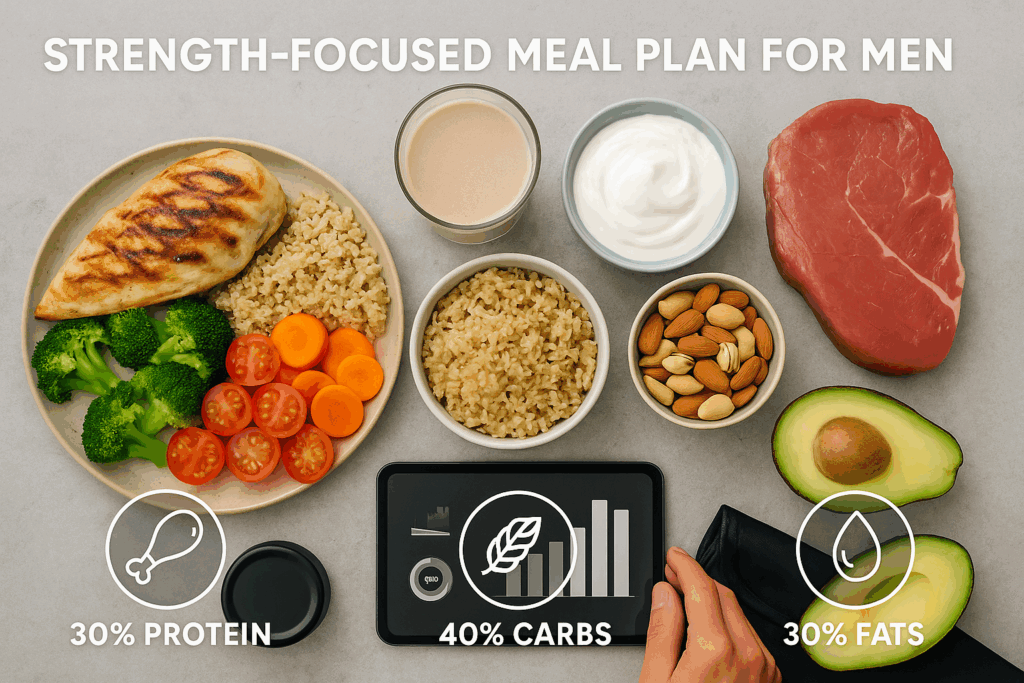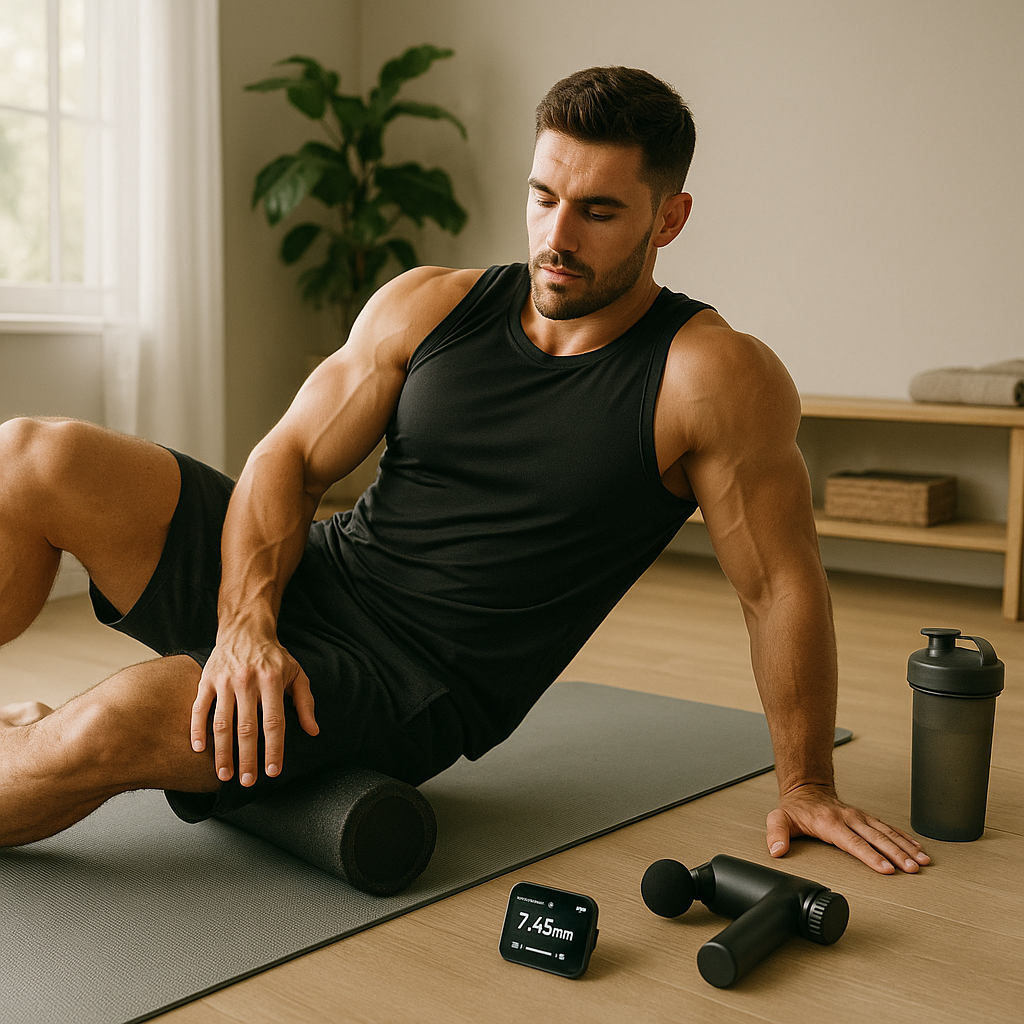Introduction: Redefining Strength for the Modern Man
Achieving peak performance in fitness is about more than building muscle or pushing heavier weights. For today’s health-conscious men, the journey is a nuanced and purposeful pursuit driven by individualized fitness goals, functional training, and long-term health outcomes. Setting and crushing fitness goals for men requires a blend of strategic planning, discipline, and tailored strength-building practices. Whether one is aiming to increase muscle mass, boost athletic performance, or simply cultivate resilience and vitality, strength training provides a critical foundation.
In the context of modern fitness trends and evolving health needs, men are increasingly focusing on sustainable and intelligent training methods. Gone are the days when brute force alone was the measure of fitness. Instead, the emphasis is shifting toward balance, mobility, and metabolic health. The integration of compound movements, periodization, and recovery strategies plays an essential role in helping men stay on course and surpass their fitness milestones. This article presents a holistic, science-backed strength plan specifically designed to help men achieve their most ambitious fitness goals while promoting lasting power and overall wellness.
You may also like: The Ultimate 30-Day Workout Plan for Men Working Out in the Gym: Proven Full Body Strength Exercises to Maximize Results
Understanding the Core Principles of Strength Training
At the heart of any successful strength training regimen lies a commitment to foundational principles that drive physiological adaptation. Central among these are progressive overload, specificity, and recovery. Progressive overload ensures the body is consistently challenged, leading to increases in muscle mass and neuromuscular efficiency. Without this principle, the body quickly adapts and plateaus, limiting further strength development.
Specificity means that training should reflect the intended fitness outcomes. For example, a man training for hypertrophy (muscle growth) must design his program differently from one focused on muscular endurance or maximal strength. Tailoring rep ranges, load percentages, rest intervals, and exercise selection according to these specific goals is critical for making meaningful progress. Equally important is the incorporation of rest and recovery protocols, as muscles need time to repair and rebuild stronger after each training session.
Many men overlook the importance of periodization, a method of organizing training into phases that target different physiological adaptations. Periodized programs alternate between periods of high intensity, volume, and recovery to prevent overtraining and maintain consistent progress. Additionally, the inclusion of mobility work, such as dynamic stretching and foam rolling, enhances movement quality, reduces injury risk, and promotes optimal performance in compound lifts.

Crafting the Right Mindset to Achieve Fitness Goals for Men
Before diving into sets and reps, it’s vital to cultivate a powerful mindset that fosters consistency, resilience, and motivation. Mental discipline is often the most underrated component of achieving fitness goals for men. While physical transformation garners most of the attention, mental fortitude is what sustains long-term success.
One foundational aspect of mindset development is goal setting. Rather than vague aspirations like “get stronger” or “build muscle,” effective goals are SMART: Specific, Measurable, Achievable, Relevant, and Time-bound. For instance, “increase bench press by 20 pounds in 12 weeks” is a goal that provides clarity and direction. This approach not only enhances motivation but also allows for objective tracking and strategic adjustments.
Equally important is managing internal dialogue. Replacing self-doubt with affirmations and outcome-driven thinking reinforces commitment. Visualization techniques, where one mentally rehearses performing exercises with precision and strength, have been shown to improve actual physical performance. Furthermore, surrounding oneself with a supportive community—whether in a gym, online forums, or training groups—offers accountability, encouragement, and shared knowledge.
Lastly, men should embrace a growth mindset. Progress isn’t always linear, and setbacks are part of the journey. Viewing challenges as opportunities for growth rather than failures builds psychological resilience, which is essential for achieving and maintaining demanding fitness goals.

The Science Behind Male Fitness Goals and Strength Adaptation
Male physiology responds uniquely to strength training due to hormonal differences, muscle fiber distribution, and metabolic characteristics. Testosterone, a primary anabolic hormone, plays a key role in muscle protein synthesis, making strength gains and hypertrophy more attainable with proper training. However, hormonal advantage alone doesn’t guarantee results without a structured and individualized program.
Muscle fibers are typically categorized into Type I (slow-twitch) and Type II (fast-twitch) fibers. While men generally possess a higher proportion of Type II fibers, which are responsible for explosive and high-intensity efforts, individual variation still matters. Understanding one’s muscle fiber dominance can inform the ratio of power-focused movements to endurance-based work in a training plan. This precision allows for the optimization of strength development while avoiding unnecessary fatigue or stagnation.
Adaptation also depends on nutritional status, sleep quality, and stress management. Nutritional strategies that support male fitness goals often include a higher protein intake to facilitate muscle repair, as well as adequate carbohydrates to fuel training sessions and replenish glycogen stores. Sleep, often underrated, is a vital recovery tool; it is during deep sleep that growth hormone peaks, accelerating muscular repair and adaptation. Stress management techniques, such as mindfulness and breathwork, help regulate cortisol levels, preventing muscle catabolism and preserving training gains.

Building a Customized Strength Training Program
Creating a customized strength training program begins with an honest assessment of one’s current fitness level, time availability, and specific objectives. While many men seek generalized strength and conditioning, others may aim for specialized performance goals such as improving deadlift numbers, increasing muscle definition, or enhancing athletic speed and power. Each goal necessitates unique training variables.
A well-balanced program includes a mix of compound lifts—such as squats, deadlifts, presses, and pulls—as these recruit multiple muscle groups and stimulate systemic growth. Accessory exercises targeting smaller muscles are equally important to correct imbalances and support joint health. Training frequency is typically optimized at three to five sessions per week, depending on intensity and recovery needs.
Training volume and intensity must be manipulated carefully. Beginners may benefit from full-body sessions emphasizing neuromuscular coordination and movement mastery, while advanced lifters often thrive on split routines targeting specific muscle groups with greater intensity. Rest periods between sets vary based on the goal: strength-focused training often requires 2-5 minutes of rest, whereas hypertrophy and endurance may involve 30-90 seconds.
Tracking progress is essential. Tools such as training logs, video analysis, and performance metrics provide valuable insights into improvement areas. Periodic assessments, like rep-max testing or body composition scans, offer objective data to guide program adjustments. Ultimately, a dynamic, evolving program ensures continual adaptation and sustainable progress.
Optimizing Nutrition for Strength and Male Fitness Goals
No strength plan is complete without a carefully tailored nutrition strategy. Nutrition fuels performance, enhances recovery, and supports physiological adaptation. For men aiming to crush their fitness goals, understanding macronutrient needs and meal timing is key.
Protein is the cornerstone of muscle repair and growth. Active men typically require 1.6 to 2.2 grams of protein per kilogram of body weight, sourced from lean meats, dairy, legumes, and quality supplements. Spacing protein intake evenly across meals ensures a steady supply of amino acids for muscle synthesis. Carbohydrates, often misunderstood, are vital for energy production. Complex carbs like oats, sweet potatoes, and whole grains should form the dietary base, especially around training times to replenish glycogen stores.
Healthy fats support hormone production, joint health, and energy balance. Sources such as avocados, nuts, seeds, and fatty fish provide essential omega-3 and omega-6 fatty acids. While caloric intake should align with the goal—whether bulking, cutting, or maintaining—the quality of calories often matters more than sheer quantity.
Meal timing plays a strategic role. Pre-workout meals rich in complex carbs and moderate protein enhance performance, while post-workout meals high in protein and fast-digesting carbs accelerate recovery. Hydration, often overlooked, is equally critical. Even minor dehydration can impair performance and cognitive function. Electrolyte balance should also be maintained, especially during intense sessions.
Supplements can enhance results when used responsibly. Creatine monohydrate, whey protein, and branched-chain amino acids (BCAAs) are among the most studied and effective options. However, no supplement can replace a nutrient-dense diet. Men pursuing long-term strength gains should focus on food quality, variety, and consistency for sustained success.

Designing Recovery Strategies to Support Strength and Power
Recovery is where growth happens. In the pursuit of male fitness goals, recovery strategies are often as important as the training itself. Without adequate recovery, even the most intelligent training plans can lead to overtraining, injury, and burnout.
Sleep remains the most powerful recovery tool. Aim for 7-9 hours of quality sleep each night, emphasizing sleep hygiene practices such as limiting screen exposure before bed, creating a dark sleep environment, and maintaining a consistent bedtime routine. Sleep directly influences hormone regulation, including testosterone and growth hormone, both critical for muscle development and fat metabolism.
Active recovery methods, such as walking, swimming, or light yoga, improve circulation, reduce muscle soreness, and enhance mobility. These low-intensity activities facilitate the removal of metabolic waste and provide mental refreshment. Passive recovery tools like massage therapy, contrast showers, and compression garments can also support recovery and reduce inflammation.
Periodization should include planned deload weeks where training intensity and volume are reduced. These periods allow for full system recovery and often precede new gains in strength and performance. Monitoring biomarkers such as resting heart rate, perceived exertion, and mood can help identify early signs of overtraining, enabling proactive recovery interventions.
Nutrition also contributes to recovery. Anti-inflammatory foods rich in antioxidants—like berries, leafy greens, and turmeric—help combat oxidative stress. Additionally, post-workout meals that include a blend of protein and carbs replenish energy stores and provide raw materials for tissue repair. Effective recovery ensures that the body remains primed for consistent progress.

Strength Training and Longevity: The Long-Term Vision
Strength training isn’t just about short-term aesthetics or performance. For men, it represents a lifelong investment in health, functionality, and vitality. As men age, maintaining muscle mass and bone density becomes increasingly important for reducing the risk of falls, fractures, and metabolic decline.
Strength training has been linked to improved insulin sensitivity, cardiovascular health, and cognitive function. It helps counteract the natural decline in testosterone and growth hormone levels associated with aging. Additionally, training with intention and proper form reduces injury risk while enabling older men to maintain independence and physical autonomy.
The concept of “functional fitness” gains significance with age. Movements that mimic daily activities—such as lifting, carrying, and squatting—preserve neuromuscular coordination and balance. Men who train consistently throughout their lives are better equipped to engage in recreational sports, travel, and everyday tasks well into their later years.
Furthermore, the mental benefits of long-term strength training are profound. The discipline, confidence, and stress relief derived from regular exercise support emotional health and resilience. In a fast-paced world, strength training becomes a grounding ritual that fosters clarity, purpose, and inner stability.
Maintaining a sustainable routine that evolves with age and changing priorities is key. Flexibility, mobility work, and adaptive programming allow men to continue training effectively while avoiding injury or burnout. Ultimately, strength training becomes a lifestyle—not just a phase—for achieving enduring power and health.

Proven Strategies to Achieve Fitness Goals for Men
Crushing fitness goals for men requires a multifaceted approach rooted in consistency, customization, and accountability. Begin by defining a clear vision: What does success look like? Whether it’s mastering a new lift, shedding body fat, or completing a competitive event, specificity fuels motivation.
Daily habits play a major role. Establishing a consistent training schedule, prioritizing sleep, and eating mindfully contribute to sustainable results. Utilizing technology—from wearable fitness trackers to training apps—can enhance tracking, provide feedback, and ensure that goals remain in focus.
Social support amplifies success. Training partners, coaches, or even online communities offer motivation, feedback, and encouragement. Men often thrive in competitive or cooperative environments, where shared purpose enhances performance.
Additionally, embracing flexibility in goal setting is vital. Life circumstances, injury, or unforeseen obstacles may necessitate recalibration. Developing a toolbox of adaptable training strategies—such as bodyweight workouts, resistance bands, or time-efficient circuits—ensures that progress doesn’t stall.
Finally, celebrate small wins along the journey. Progress isn’t measured solely by aesthetics or weight lifted; it includes energy levels, mental sharpness, and overall vitality. Recognizing these victories reinforces consistency and fosters a deeper connection to the training process.

Why Male Fitness Goals Demand Strategic Strength Planning
Male fitness goals extend beyond surface-level improvements. Whether driven by aesthetics, performance, or health, they require intelligent programming rooted in science and personalization. Too often, men adopt random workout routines without aligning them to their desired outcomes, resulting in wasted effort and stagnation.
A strategic strength plan begins with needs assessment: What are the individual’s strengths, limitations, and lifestyle constraints? From there, a roadmap is created with built-in progression, recovery, and feedback mechanisms. This scientific approach increases efficiency, reduces injury risk, and supports sustainable gains.
Hormonal considerations are also important. Periods of high stress, inadequate sleep, or poor nutrition can disrupt hormonal balance and undermine progress. A well-structured plan takes these variables into account, optimizing training around life demands and physiological readiness.
By aligning training with evidence-based principles and individual goals, men can unlock their full potential. From building lean muscle to enhancing metabolic health, strategic strength planning transforms intention into achievement. More than just lifting weights, it’s about constructing a lifestyle that champions discipline, adaptability, and purpose.
Frequently Asked Questions: Advanced Strength Training and Male Fitness Goals
1. How Do Hormonal Changes Impact Long-Term Male Fitness Goals?
Hormonal fluctuations, particularly involving testosterone and cortisol, can significantly influence the success and sustainability of male fitness goals. Testosterone plays a critical role in muscle protein synthesis, strength development, and energy regulation. However, levels may fluctuate due to factors like aging, chronic stress, inadequate sleep, or poor nutrition. Monitoring hormonal health through regular blood panels and working with medical professionals can ensure that imbalances are addressed proactively. Incorporating stress reduction techniques, prioritizing quality sleep, and including healthy fats in the diet can support hormone regulation, ultimately helping men sustain strength and vitality over time.
2. What Role Does Functional Training Play in Supporting Fitness Goals for Men?
Functional training enhances movement patterns that mimic real-life activities, making it a valuable addition to any strength-focused regimen. It builds neuromuscular coordination, balance, and joint stability, which are especially important for aging men or those recovering from injury. Integrating functional exercises such as kettlebell swings, sled pushes, and sandbag carries supports better posture, mobility, and injury prevention. Unlike isolated machine exercises, these movements engage multiple muscle groups simultaneously, offering more comprehensive results. By aligning with practical performance needs, functional training helps men progress toward fitness goals with a focus on both form and function.
3. Are There Psychological Barriers That Commonly Prevent Men from Achieving Their Fitness Goals?
Yes, many men struggle with internal barriers that subtly sabotage progress toward fitness goals. These can include perfectionism, fear of failure, or comparing oneself to others in the gym or online. Social conditioning may also discourage men from expressing vulnerability, preventing them from seeking coaching or support when needed. Mental fatigue, self-sabotage, and inconsistent motivation often stem from unclear goals or lack of personal meaning behind the pursuit of fitness. Reframing fitness as a journey rather than a destination and connecting training to deeper values such as family longevity, mental clarity, or stress relief can reignite intrinsic motivation and drive lasting commitment.
4. How Can Strength Training Enhance Cognitive Function and Brain Health?
Emerging research shows that strength training offers significant cognitive benefits for men, especially as they age. Resistance training has been associated with improvements in memory, attention span, and executive functioning due to enhanced blood flow to the brain and the release of brain-derived neurotrophic factor (BDNF). Regular training may also reduce the risk of neurodegenerative diseases such as Alzheimer’s. Compound movements, which require coordination and focus, can strengthen cognitive-motor integration. This makes strength training a dual investment: not only in physical power but in mental acuity, promoting both brain and body longevity.
5. What Nutritional Gaps Commonly Undermine Male Fitness Goals?
Even well-structured strength programs can fall short if dietary gaps aren’t addressed. Many men under-consume micronutrients like magnesium, zinc, and vitamin D, all of which play roles in recovery, energy metabolism, and hormonal health. Inadequate fiber intake is another issue, potentially affecting digestion and nutrient absorption. Busy lifestyles may lead to reliance on processed foods, which lack the nutrient density needed for optimal performance. Addressing these gaps with a whole-food-based approach and strategic supplementation ensures the body has the tools it needs to repair, rebuild, and grow, reinforcing long-term fitness results.
6. How Can Men Stay Motivated During Plateaus in Their Strength Progress?
Plateaus are a natural part of any strength journey, but they can be disheartening. One powerful strategy for overcoming plateaus is to introduce variety—changing the stimulus through new exercises, tempo adjustments, or different training splits. Tracking performance metrics beyond just the scale or mirror, such as improved sleep, energy, or mobility, can provide alternative markers of progress. Setting short-term process goals, like mastering a new lift or improving form, fosters continued engagement. Additionally, participating in fitness challenges or hiring a coach can inject new enthusiasm and accountability, reigniting motivation and commitment.
7. What Are Some Effective Recovery Techniques Beyond Sleep and Nutrition?
While sleep and diet are foundational, advanced recovery strategies can further accelerate results and reduce injury risk. Myofascial release through tools like massage guns and foam rollers enhances circulation and reduces muscle tightness. Infrared sauna therapy and contrast baths can stimulate circulation and promote detoxification, aiding recovery from intense sessions. Breathwork practices such as box breathing or alternate nostril breathing activate the parasympathetic nervous system, lowering cortisol and enhancing restfulness. These holistic approaches support not just muscular repair but nervous system recalibration, creating a more robust recovery protocol for serious strength athletes.
8. How Do Social and Cultural Expectations Influence Fitness Goals for Men?
Cultural narratives around masculinity often influence how men approach their fitness goals. The pressure to attain a particular physique or achieve elite performance can lead to unrealistic expectations and unhealthy behaviors. Social media often amplifies these ideals, sometimes promoting aesthetics over genuine health. It’s important for men to define their fitness goals on their own terms, considering factors like lifestyle, age, health conditions, and personal values. Developing self-awareness and rejecting comparison-based benchmarks allows for more authentic, sustainable progress and a healthier relationship with fitness overall.
9. Advanced Programming Tips for Sustaining Fitness Goals for Men
For men who have mastered the basics and are looking to sustain long-term gains, advanced programming techniques offer renewed momentum. Autoregulation, which involves adjusting training intensity based on daily readiness, allows men to train hard without risking overtraining. Incorporating velocity-based training (VBT) helps maintain power output and precision, particularly in explosive lifts. Periodic testing of relative strength and muscular endurance provides insights for program refinement and highlights weaknesses to address. Layering these techniques into your program can enhance adaptability and responsiveness, key elements in sustaining advanced male fitness goals.
10. What Innovations Are Shaping the Future of Male Fitness Goals?
The landscape of male fitness goals is evolving with innovations in technology, data tracking, and personalization. Wearable tech now provides real-time insights into heart rate variability, sleep cycles, and recovery readiness, allowing for precision training. Artificial intelligence is being used to generate adaptive workout plans based on biometric data and performance trends. Virtual coaching platforms enable access to expert programming from anywhere in the world. Additionally, holistic wellness integration—merging strength, mental health, and longevity metrics—is becoming central to male fitness strategies. As tools become more personalized and integrative, achieving and maintaining fitness goals for men will become more efficient, informed, and sustainable.
Conclusion: A Lasting Blueprint for Strength and Fitness Success
Strength is not just a physical attribute—it is a mindset, a lifestyle, and a long-term investment in one’s health and vitality. Achieving fitness goals for men involves more than lifting heavier weights or hitting aesthetic milestones. It demands a thoughtful integration of training principles, nutritional science, recovery strategies, and mental resilience. Each element plays a crucial role in building a sustainable foundation for lasting power.
By understanding the nuances of male physiology, adapting workouts to individual goals, and embracing a lifelong commitment to movement, men can craft a blueprint for success that transcends fleeting trends. Whether you’re just starting out or have years of experience, the path to enduring strength begins with intention and action.
Let this ultimate strength plan serve as a guide, a motivation, and a framework. Not only will it empower you to crush your current goals, but it will also support a life defined by health, vitality, and purposeful achievement.
Further Reading:
What Are Some Realistic Weight Lifting Goals To Aim For?
Workout Routines for Men: The Ultimate Guide
10 Realistic Fitness Goals, Recommended by Personal Trainers





